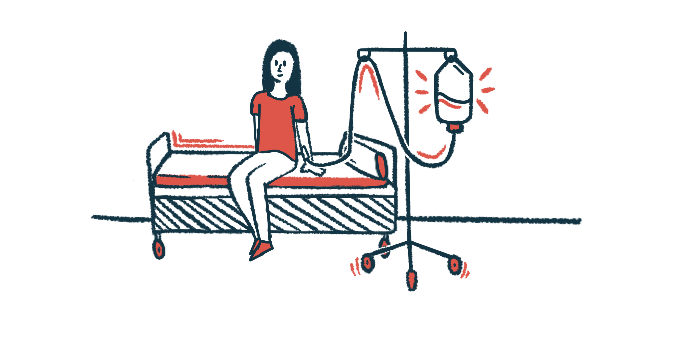CAD treatment riliprubart may be given every 3 months: Study
Modeling, clinical trial results show fixed-dose regimen could benefit patients

Riliprubart (SAR445088), a potential successor to Enjaymo (sutimlimab-jome) as a cold agglutinin disease (CAD) treatment, may achieve therapeutic levels with every-three-month dosing at a fixed dose.
That’s according to a study that used modeling tools to analyze available clinical trial data and propose an optimal dosing regimen for the experimental therapy. The regimen was then validated in nine CAD patients participating in a Phase 1 clinical trial.
Given that Enjaymo, the only approved CAD treatment, is given at a weight-based dose every other week after two initial weekly doses, having a fixed-dose quarterly dosing regimen for riliprubart “could benefit patients and healthcare providers,” the researchers wrote.
The study, “Confirmation of Fixed Quarterly Riliprubart Regimen in Patients with Cold Agglutinin Disease Using Population PK/PD and Exposure-Response Analyses,” was published in Clinical Pharmacology & Therapeutics by a trio of researchers at Sanofi, which developed both therapies. Recordati acquired the rights to Enjaymo last year.
In CAD, self-reactive antibodies called cold agglutinins mistakenly attack red blood cells at cold temperatures, promoting the cells’ destruction, or hemolysis. The immune complement cascade, particularly its classical pathway, is involved in this process.
CAD treatment via infusion
Enjaymo is an antibody-based therapy designed to block both inactivated and activated forms of C1s complement protein, which is responsible for initiating the classical complement cascade.
Administered directly into the bloodstream via infusions once weekly for the first two weeks and every other week thereafter, the therapy was shown to significantly reduce hemolysis and CAD symptoms.
Riliprubart (formerly BIVV020, SAR445088) is a second-generation infusion therapy that selectively blocks the active form of C1s but not the inactive form, which is found at much higher levels, so less therapy is wasted on non-targets.
This, along with other modifications that make it last longer in the body, means that riliprubart may be given at lower doses and/or less frequently than Enjaymo.
In cell-based models of CAD, riliprubart effectively blocked the complement pathway and reduced hemolysis. Similar results were seen in healthy volunteers participating in a placebo-controlled Phase 1 study.
Building on these findings, Sanofi launched a Phase 1b trial (NCT04269551) that tested riliprubart in 12 adults with CAD. Data showed that a single infusion of either of two riliprubart weight-based doses (15 or 30 mg/kg) was well tolerated and led to a sustained reduction in hemolysis.
Model-informed drug development
Sanofi scientists used a model-informed drug development (MIDD) approach and available clinical data to propose a dosing regimen for riliprubart. For the model, they created a virtual population of 1,000 CAD patients from a clinical database.
Based on the fact that it takes eight to 15 weeks for blood riliprubart levels to be reduced by half, the researchers initially considered an every-three-month, or quarterly, regimen, with an additional dose at day 29.
This regimen was evaluated via simulation at the two weight-based doses, 30 mg/kg and 50 mg/kg, and a 3.5 g fixed dose. Only the 50 mg/kg and 3.5 g doses were projected to achieve the blood riliprubart levels needed to effectively engage active C1s for more than 90% of the patient population.
Changes in exposure from extremely low body weight to extremely high body weight differed between the two doses, but exposure was generally comparable for most CAD patients, who weigh 65-105 kg (143-231 pounds).
The 3.5 g fixed dose also had an acceptable safety margin, or the fold difference between a dose that causes severe side effects and an effective dose, at all body weight groups. That led the team to recommend the 3.5 g quarterly riliprubart regimen with an additional day 29 dose for CAD patients.
To confirm these results, the researchers examined drug exposure and clinical outcomes in nine CAD patients who were given the regimen in a Europe-based Phase 1 trial (NCT04802057). All but one participant had received riliprubart in previous trials.
Blood riliprubart levels up to the sixth infusion matched the simulated findings. The proposed regimen led to a rapid and sustained drop in blood CH50 levels, a marker of classical complement pathway activation, in all participants.
Mean blood level of hemoglobin, the protein in red blood cells that carries oxygen, was maintained through week 48, or nearly one year. Similar results were observed for the mean level of bilirubin, a byproduct of hemolysis.
Four patients experienced adverse events: iron deficiency, recurrent hemolysis, fatigue, and acrocyanosis, a CAD symptom marked by a bluish skin discoloration that occurs when blood vessels are blocked. Only acrocyanosis was deemed related to riliprubart, leading to temporary treatment interruption.
“Based on the totality of the efficacy, safety, and [pharmacological] data observed under clinical evaluation, the proposed dose regimen demonstrated suitability for CAD patients,” the researchers wrote.
Among the benefits of fixed dosing, the team noted “reduced dosing errors and [between-patient] variability, and increased efficiency of dosing preparation,” as well as a potential to “reduce the cost of drugs with limited vial sizes and reduce wastage of drugs.”
“The use of MIDD approaches could lead to fewer subjects and improved efficiency for drug development, particularly in rare diseases,” the researchers concluded.







